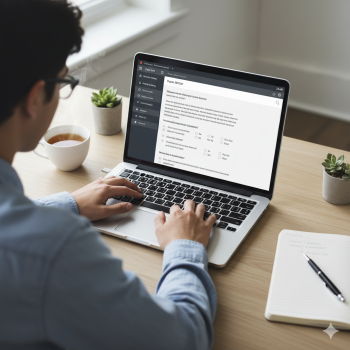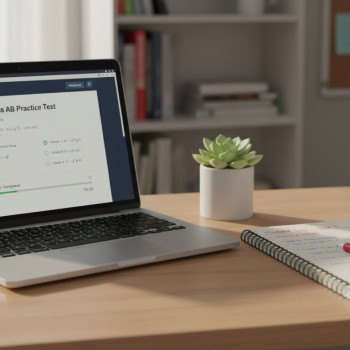Introduction: You’re Not Alone — And You’re Closer Than You Think
Juggling school, a part-time job, extracurriculars, and the looming SAT feels like walking a tightrope. You’re not failing if you’re tired or if your study window is short — you’re doing the modern student’s hardest work: managing responsibilities and planning for the future. This post is a friendly, no-fluff guide to studying for the Digital SAT while working part-time. It’s practical, human, and built for the reality that most students don’t have unlimited free time.
Why a Smart Plan Beats a Long One
Many students assume hours logged equals results. But when your waking hours are already taxed, efficiency is the superpower. Two hours of focused, strategic practice can beat five hours of distracted studying. We’ll focus on quality, predictability, and recovery — so your brain actually learns and retains.
Think Small, Consistent, and Focused
When you work a part-time job, your best friend in SAT prep is consistency. Small, daily wins add up faster than binge-cramming on a weekend when shifts are off. Build short habits (25–50 minutes) that fit between shifts, after homework, or in the commute. That steady rhythm reduces stress and keeps material fresh.
Set Priorities: What to Study and When
Before you spend time, spend five minutes planning. Prioritize tasks that are high-impact: targeted practice on weak areas, timed practice sections, and reviewing mistakes. Here’s a hierarchy that usually works:
- Master the test format: know question types, timing, and digital interface basics for the Digital SAT.
- Target weaknesses: use practice tests to identify trends — is it reading comprehension, Algebra, grammar, or pacing?
- Practice under time constraints: timing is one of the biggest score-killers.
- Review results critically: understand why an answer was wrong — that’s where learning happens.
Example: Two-Week Micro-Cycle
Use this short cycle during busy weeks. It’s flexible and repeatable.
- Days 1–2: Diagnostic and targeted practice (identify 2 weak areas).
- Days 3–9: Focused practice sessions (alternate math and evidence-based reading & writing).
- Day 10: Timed practice section + review.
- Day 11: Rest or light review (flashcards, quick vocab).
- Days 12–14: Repeat with tweaks based on performance.
Time Management: Build a Real Schedule Around Work
Part-time work rarely has the predictability of a school day. You need a plan that adapts without collapsing. Start with an honest audit:
- List fixed commitments: work shifts, classes, sleep goal, and family obligations.
- Highlight reusable pockets: commute (if you don’t drive), lunch breaks, early mornings, and downtime between tasks.
- Reserve 3–5 time blocks each week that are designated SAT time. Treat them like shifts — show up, even if it’s just 30 focused minutes.
Sample Weekly Schedule (for a student working 12–20 hours/week)
| Day | Before School | After School | After Work / Evening |
|---|---|---|---|
| Monday | 20 min: vocab/reading warm-up | 45 min: targeted math practice | 30 min: review mistakes |
| Tuesday | 20 min: grammar drills | Shift (work) | 50 min: timed reading section (digital format) |
| Wednesday | 30 min: flashcards | 60 min: problem-solving practice | Relax / light review |
| Thursday | 20 min: targeted review | Shift (work) | 45 min: practice essay-style reasoning (if applicable) |
| Friday | Rest | Shift (work) | 30 min: error log update |
| Saturday | 1–2 hours: full practice section or diagnostic | Shift (work) | Recovery time |
| Sunday | 60 min: review weak topics | Plan next week | Family / downtime |
Adapt the blocks to your energy cycles. If you’re sharper in the morning, put harder tasks there. If you’re drained after a shift, save review or lighter tasks for that time.
High-Impact Study Techniques for Short Windows
When you have limited time, choose techniques that maximize retention and transfer to the test.
1. Active Practice, Not Passive Reading
Don’t just read solutions — do them. Active practice means solving, timing yourself, and explaining answers aloud or in a short note. Passive tasks (like skimming a review book) feel productive but give you little return on investment.
2. The Error Log — Your Most Valuable Tool
Keep a simple error log: question, correct answer, why you missed it, and one action (e.g., review a concept). Spend 10 minutes before each session reviewing recent errors so you don’t repeat them.
3. Timed, Section-Focused Practice
Instead of full tests every time, practice one section with strict timing. This builds pacing skills and reduces test-day panic. Rotate sections through the week so each receives attention.
4. Spaced Repetition for Vocabulary/Rules
Use flashcards (physical or app) and short daily reviews. Spaced repetition helps vocabulary and grammar rules stick without large time investments.
How to Use Work Time as an Asset, Not an Obstacle
Your job gives you discipline, responsibility, and often pockets of time. Use them creatively:
- Commutes: listen to short reading passages or verbal explanations of math strategies if you aren’t driving.
- Breaks: 10–15 minute targeted drills (one riddle-style math problem or a quick passage).
- Cashier downtime: review flashcards on a phone (if your workplace allows it).
These small study microbursts add up without disrupting work performance. Be respectful of your job — if studying there is frowned upon, keep it to after-shift reviews and mental walkthroughs on the way home.
Self-Care: Sleep, Nutrition, and Burnout Prevention
Prep suffers when you’re exhausted. Protect your sleep and recovery like they’re the most important study tools — because they are. Memory consolidation happens during sleep, so skimping can erase gains.
Practical Self-Care Tips
- Aim for consistent sleep times even if shift schedules fluctuate. Short naps (20–30 minutes) can help after long shifts.
- Pack simple, healthy snacks to keep energy steady during shifts and study blocks.
- Schedule at least one full day or evening off per week to recharge.
When to Ask for Help — And How to Ask Smart
If you’re spinning in circles on the same problem types, it’s time to get help. You don’t need a dramatic breakdown to justify tutoring — efficient, targeted help accelerates progress.
How Personalized Tutoring Can Fit Your Schedule
A tutor who understands your life can create short, focused sessions that match your weaknesses and time constraints. For example, Sparkl’s personalized tutoring offers 1-on-1 guidance and tailored study plans designed to slot into busy schedules. Short weekly sessions focused on your biggest leaks can be transformational: fewer hours overall, better targeted practice, and clear homework that you can do in small bursts between shifts.
Practice Tests: Frequency, Format, and What to Do with Results
Full tests matter — they’re the only way to simulate endurance and pacing — but they’re time-consuming. If you work a part-time job, try this approach:
- Take one full practice test every 2–3 weeks when your schedule allows.
- Between full tests, do timed sections and micro-tests (30–60 minute blocks).
- Immediately review your test with an eye for patterns — not just the number wrong.
What to Track After Each Test
- Score by section and question-type performance.
- Timing issues: did you rush or get stuck?
- Careless vs. conceptual errors: which is more common?
Real-World Examples: Two Student Stories
Stories help make this concrete. What follows are realistic, condensed examples — names changed, situations plausible.
Case 1: Maya — Barista, 15 Hours/Week
Maya worked weekend and afternoon shifts. Her approach: 30–45 minute practice sessions in the morning before school and a single focused 60-minute session after shifts twice a week. She kept an error log and used Thursday evenings for timed reading practice. In six weeks she moved from inconsistent section scores to consistent pacing and cut careless errors by half.
Case 2: Jamal — Retail Associate, 18 Hours/Week
Jamal’s shifts varied week-to-week. He used a two-week micro-cycle (described earlier), focusing on one topic per week and using work breaks for short review. When he hit a persistent algebra weakness, he booked targeted, weekly 1-on-1 sessions with a tutor who set 20-minute practice tasks aligned with his shifts. That focused support eliminated confusion and improved his math accuracy substantially.
Study Tools and Resources That Respect Your Time
Choose tools that give fast feedback and allow targeted practice. Prioritize digital tools that simulate the Digital SAT experience so you’re not surprised by the test interface. If you use a tutoring program like Sparkl, ask for AI-driven insights and tailored homework — these can save time by focusing you on the exact skills that move the score needle.
Balance: Work, Life, and the SAT — A Few Hard Truths
1) You may not be able to chase a perfect score while working long hours. That’s OK. Aim for the best score that fits your timeline and goals.
2) Flexibility trumps rigidity. If you had a heavy week at work, don’t punish yourself — adjust the plan and return with a refreshed schedule.
3) Communicate with your employer if possible. Some supervisors respect students’ academic commitments and can occasionally swap shifts or allow brief flexibility during test week.
Final Sprint: What to Do in the Last Month
The final month before test day should be about plugging holes, solidifying pacing, and ensuring physical readiness.
- Take 1–2 full practice tests early in the month and one final full test about a week before the exam.
- Prioritize weak topics but avoid learning brand-new strategies in the last week.
- Reduce study time slightly in the final 3–4 days to protect sleep and energy.
- Practice test logistics: device familiarity (for Digital SAT), allowed calculators (if any), and test-day routine.
Checklist for Test Day (Work-Friendly)
- Confirm test time and digital setup the week before.
- Schedule your work shifts to avoid late-night shifts the day before the test whenever possible.
- Pack snacks, water, and any allowed materials for test breaks.
- Get a full night’s sleep and a light breakfast that morning.
Closing Notes: You’re Doing Important, Valuable Work
Balancing a job and SAT preparation is not a weakness — it’s an impressive life skill. Employers value responsibility; colleges value resilience. The strategies here are designed to help you study smarter, not harder, and to protect your well-being while you chase college goals. If you want individualized structure, consider short, focused 1-on-1 tutoring sessions that can be tailored to your schedule and designed around your exact weaknesses. Personalized guidance — like Sparkl’s tailored study plans and expert tutors — can make the difference between spinning your wheels and making measurable progress.
Action Plan: Your Next Seven Days
Here’s a simple, realistic week to start right now. Copy it into your calendar and treat each block like a shift you can’t skip.
- Day 1: 30 minutes diagnostic (one section) + 15 minutes error log.
- Day 2: 40 minutes targeted practice on weakest topic.
- Day 3: 50 minutes timed reading section.
- Day 4: 30 minutes grammar/vocab with flashcards.
- Day 5: 60 minutes math practice (problem sets).
- Day 6: 90 minutes: mini practice test (two sections) + review.
- Day 7: Rest or active recovery (light review of error log).
One Final Thought
Progress is often invisible day-to-day. Measure your journey by the habits you build and the clarity you gain about the test, not only by the numbers on a practice test. Keep adjusting, be kind to yourself, and use the tools that slot into your real life — because that’s where learning sticks.
Quick Resources List (For Your Planner)
Use these categories as anchors when choosing materials and support:
- Timed digital practice (simulate test interface)
- Targeted drills for weak content areas
- Error log and spaced repetition tools
- Short, regular 1-on-1 sessions for guidance and accountability
Parting Encouragement
Working while preparing for the SAT is a smartphone-level balancing act: sometimes messy, often challenging, but absolutely doable. Build a schedule that respects your energy, aim for short, focused study bursts, and don’t be afraid to get help that’s tailored to your life. You’re building habits that matter beyond the test — time management, grit, and the ability to ask for support. Those qualities are already making you college-ready.

















No Comments
Leave a comment Cancel